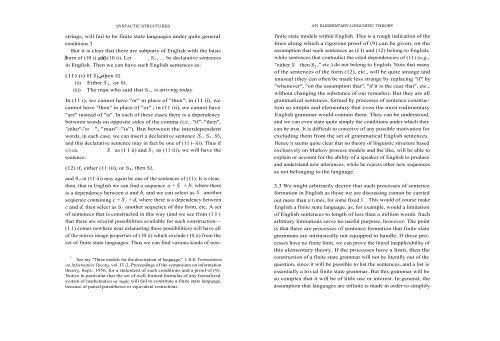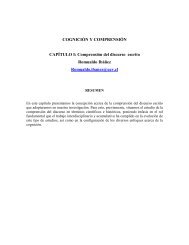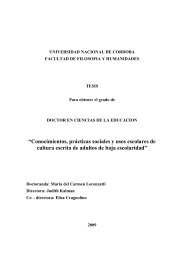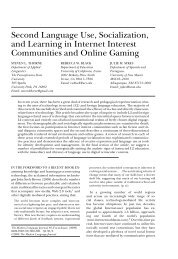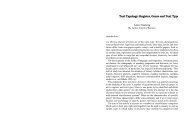Syntactic Structures
Syntactic Structures
Syntactic Structures
Create successful ePaper yourself
Turn your PDF publications into a flip-book with our unique Google optimized e-Paper software.
SYNTACTIC STRUCTURES<br />
strings, will fail to be finite state languages under quite general<br />
conditions.3<br />
But it is clear that there are subparts of English with the basic<br />
Sform<br />
of (10 i) and , S2 (10 ii). Let , S 3 , ... be declarative sentences<br />
in English. Then we can have such English sentences as:<br />
(11) (i) If S 1 , then S2.<br />
(ii)<br />
1 11,<br />
Either S3, or S4.<br />
(iii) The man who said that S 5 , is arriving today.<br />
In (11 i), we cannot have "or" in place of "then"; in (11 ii), we<br />
cannot have "then" in place of "or" ; in (11 iii), we cannot have<br />
"are" instead of "is". In each of these cases there is a dependency<br />
between words on opposite sides of the comma (i.e., "if"–"then",<br />
"either"-"or ", "man"–"is"). But between the interdependent<br />
words, in each case, we can insert a declarative sentence S„ S 3 , S5,<br />
and this declarative sentence may in fact be one of (11 i–iii). Thus if<br />
in (I l i) we take S<br />
sentence:<br />
(12) if, either (11 iii), or S4, then S2,<br />
as (I 1 ii) and S 3 as (11 iii), we will have the<br />
and S5 in (11 iii) may again be one of the sentences of (11). It is clear,<br />
then, that in English we can find a sequence a + S + b, where there<br />
is a dependency between a and b, and we can select as S another<br />
sequence containing c + S2 + d, where there is a dependency between<br />
c and d, then select as S 2 another sequence of this form, etc. A set<br />
of sentences that is constructed in this way (and we see from (1 I )<br />
that there are several possibilities available for such construction—<br />
(1 1) comes nowhere near exhausting these possibilities) will have all<br />
of the mirror image properties of (10 ii) which exclude (10 ii) from the<br />
set of finite state languages. Thus we can find various kinds of non-<br />
3 See my "Three models for the description of language," I. R.E. Transactions<br />
on Information Theory, vol. IT-2, Proceedings of the symposium on information<br />
theory, Sept., 1956, for a statement of such conditions and a proof of (9).<br />
Notice in particular that the set of well-formed formulas of any formalized<br />
system of mathematics or logic will fail to constitute a finite state language,<br />
because of paired parentheses or equivalent restrictions.<br />
AN ELEMENTARY LINGUISTIC THEORY<br />
finite state models within English. This is a rough indication of the<br />
lines along which a rigorous proof of (9) can be given, on the<br />
assumption that such sentences as (I I) and (12) belong to English,<br />
while sentences that contradict the cited dependencies of (11) (e.g.,<br />
"either S then S2 ," etc.) do not belong to English. Note that many<br />
of the sentences of the form (12), etc., will be quite strange and<br />
unusual (they can often be made less strange by replacing "if" by<br />
"whenever", "on the assumption that", "if it is the case that", etc.,<br />
without changing the substance of our remarks). But they are all<br />
grammatical sentences, formed by processes of sentence construction<br />
so simple and elementary that even the most rudimentary<br />
English grammar would contain them. They can be understood,<br />
and we can even state quite simply the conditions under which they<br />
can be true. It is difficult to conceive of any possible motivation for<br />
excluding them from the set of grammatical English sentences.<br />
Hence it seems quite clear that no theory of linguistic structure based<br />
exclusively on Markov process models and the like, will be able to<br />
explain or account for the ability of a speaker of English to produce<br />
and understand new utterances, while he rejects other new sequences<br />
as not belonging to the language.<br />
3.3 We might arbitrarily decree that such processes of sentence<br />
formation in English as those we are discussing cannot be carried<br />
out more than n ti mes, for some fixed ll . This would of course make<br />
English a finite state language, as, for example, would a limitation<br />
of English sentences to length of less than a million words. Such<br />
arbitrary limitations serve no useful purpose, however. The point<br />
is that there are processes of sentence formation that finite state<br />
grammars are intrinsically not equipped to handle. If these processes<br />
have no finite limit, we can prove the literal inapplicability of<br />
this elementary theory. If the processes have a limit, then the<br />
construction of a finite state grammar will not be literally out of the<br />
question, since it will be possible to list the sentences, and a list is<br />
essentially a trivial finite state grammar. But this grammar will be<br />
so complex that it will be of little use or interest. In general, the<br />
assumption that languages are infinite is made in order to simplify


